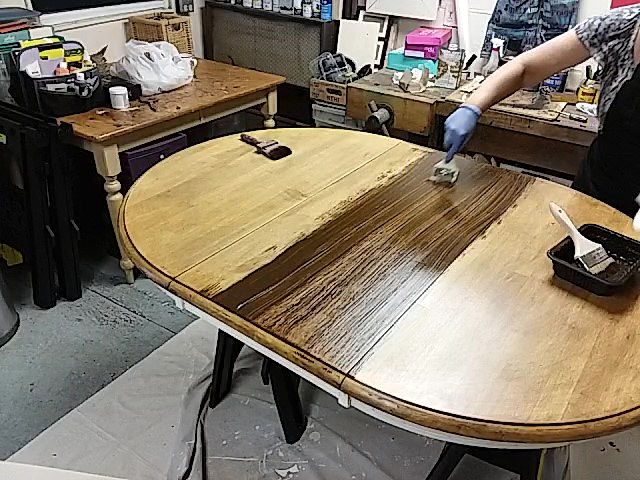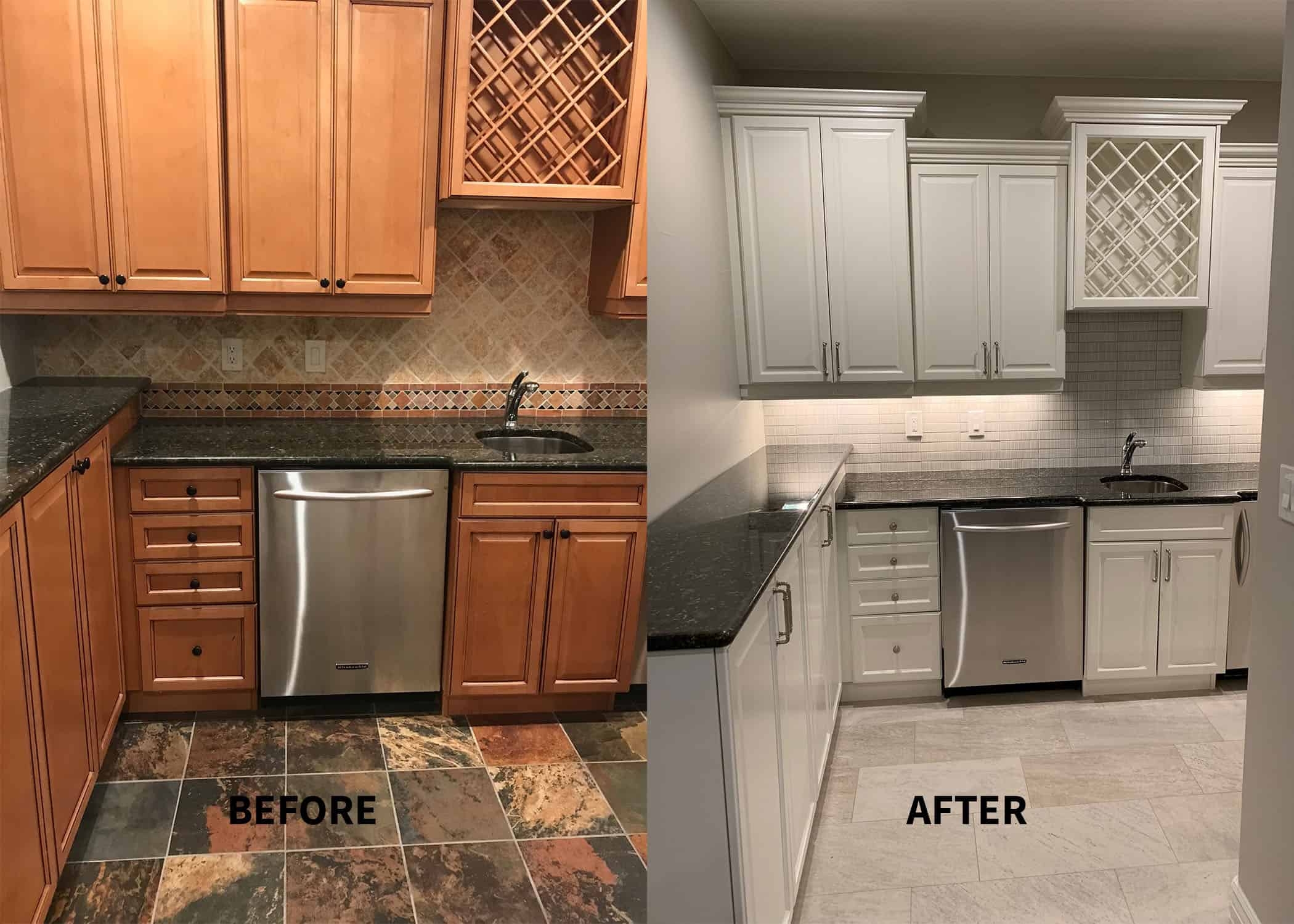Staining a kitchen table is a great way to refresh its look and add a touch of warmth to your dining space. It may seem like a daunting task, but with the right tools and techniques, it can be an easy and rewarding DIY project. Here are the steps to follow for a successful kitchen table staining project.How to Stain a Kitchen Table
When it comes to choosing a stain for your kitchen table, there are a few factors to consider. The type of wood, the color you want to achieve, and the level of protection you need all play a role in selecting the best stain for your table. Some popular options include Minwax, Varathane, and General Finishes. Make sure to choose a stain that is specifically designed for wood surfaces.Best Stains for Kitchen Tables
If you're planning on staining your kitchen table yourself, here are a few tips to keep in mind. First, make sure to wear protective gear such as gloves and a mask to avoid any contact with harmful chemicals. It's also important to work in a well-ventilated area. Additionally, always test the stain on a small, inconspicuous area of the table first to ensure you're happy with the color.DIY Kitchen Table Staining Tips
When it comes to updating your kitchen table, you may be torn between staining and painting. While both options can give your table a fresh look, staining allows the natural beauty of the wood to shine through, while painting completely covers it. If you want to preserve the natural wood grain, staining is the way to go.Staining vs Painting a Kitchen Table
Preparing your kitchen table for staining is crucial to achieve a smooth and even finish. First, remove any existing finish or paint using sandpaper or a paint stripper. Next, sand the surface of the table with a fine-grit sandpaper to smooth out any imperfections. Make sure to wipe away any dust or debris before moving on to the staining process.Steps for Preparing a Kitchen Table for Staining
Choosing the right stain color for your kitchen table can be overwhelming, as there are countless options available. To make the decision easier, consider the color of your kitchen cabinets and flooring. You want to choose a stain color that complements the existing elements in your kitchen. Warm tones like golden oak or honey pine can add a cozy feel, while darker tones like espresso or walnut can create a more modern look.Choosing the Right Stain Color for Your Kitchen Table
Now comes the fun part – applying the stain to your kitchen table. First, stir the stain thoroughly to ensure an even color. Then, using a brush or a clean cloth, apply the stain in the direction of the wood grain. Make sure to wipe off any excess stain with a clean cloth before it dries. For a darker color, you may need to apply multiple coats, allowing each coat to dry completely before applying the next.How to Properly Apply Stain to a Kitchen Table
While staining a kitchen table can be a straightforward process, there are a few common mistakes to avoid. First, make sure to sand the table properly to avoid a blotchy finish. Also, don't apply too much stain at once, as it can create a thick, uneven coat. Lastly, make sure to protect the surrounding area with drop cloths to avoid any accidental spills or drips.Common Mistakes to Avoid When Staining a Kitchen Table
To keep your newly stained kitchen table looking beautiful, it's important to protect and maintain it properly. Apply a clear coat of varnish or polyurethane to seal the stain and protect it from moisture and scratches. For regular maintenance, simply wipe the table with a damp cloth and avoid using harsh chemicals or abrasive materials.How to Protect and Maintain a Stained Kitchen Table
Still not sure if staining your kitchen table is the right choice for you? Take a look at some before and after photos for inspiration. You'll be amazed at the difference a new stain can make in the appearance of a kitchen table. With a little time and effort, you can transform your old, worn-out table into a beautiful centerpiece for your dining space.Staining a Kitchen Table: Before and After Inspiration
Why Staining a Kitchen Table is the Perfect Way to Revamp Your Dining Space
 When it comes to designing a house, the dining area is often overlooked. We tend to focus on the living room, bedroom, and kitchen, forgetting that the dining area is just as important. But with the rise of open floor plans, the dining area has become an integral part of the overall design of a house. And what better way to make a statement in your dining space than by
staining your kitchen table
?
When it comes to designing a house, the dining area is often overlooked. We tend to focus on the living room, bedroom, and kitchen, forgetting that the dining area is just as important. But with the rise of open floor plans, the dining area has become an integral part of the overall design of a house. And what better way to make a statement in your dining space than by
staining your kitchen table
?
Stain Your Way to a Beautiful Dining Space
Choose Your Stain Wisely
 When it comes to staining a kitchen table, the options are endless. From light to dark, matte to glossy, there is a stain for every design preference.
Dark stains
can add a touch of sophistication and warmth to your dining space, while
light stains
can create a bright and airy atmosphere. You can also
custom mix
stains to achieve a unique and personalized color for your kitchen table.
When it comes to staining a kitchen table, the options are endless. From light to dark, matte to glossy, there is a stain for every design preference.
Dark stains
can add a touch of sophistication and warmth to your dining space, while
light stains
can create a bright and airy atmosphere. You can also
custom mix
stains to achieve a unique and personalized color for your kitchen table.
Easy and Versatile Application
Breathe New Life into Your Dining Space
 A stained kitchen table is not just a piece of furniture, it is a statement. It adds character and charm to your dining space, making it a warm and inviting place for family and friends to gather and create memories. So if you're looking to revamp your dining area, consider staining your kitchen table. It's a simple and effective way to elevate the design of your house and bring new life to your dining space.
A stained kitchen table is not just a piece of furniture, it is a statement. It adds character and charm to your dining space, making it a warm and inviting place for family and friends to gather and create memories. So if you're looking to revamp your dining area, consider staining your kitchen table. It's a simple and effective way to elevate the design of your house and bring new life to your dining space.










































































































